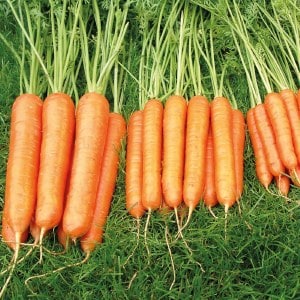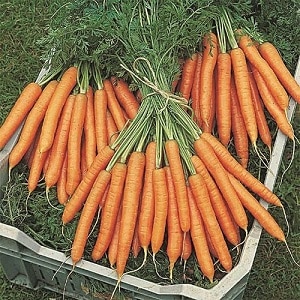Carrot harvesting dates in Siberia: when is the best time to harvest
In Russia, carrots are the second most popular vegetable after potatoes. And this is not surprising: bright orange root vegetables are not only healthy, but also tasty. In addition, the vegetable is perfectly stored in winter and replenishes our diet with vitamins and microelements during the long winter months.
In order for the harvest of vitamin-rich root crops to be stored for a long time and without loss, carrots must be removed from the garden in time and stored. In this article we will talk about when to harvest carrots in Siberia.
Optimal harvesting times in Siberia

Carrots are cold-resistant plants. Moreover, it is during cold weather that an intensive outflow of nutrients from the tops into the fruit begins.
Need to know. At the end of August and beginning of September, carrots are still actively growing. The increase in yield during this period averages 40-45%.
Therefore, digging carrots earlier than expected leads to a shortage of harvest and small root crops. Such vegetables wither quickly and are poorly stored.
The most favorable time for harvesting in Siberia is considered to be the middle and end of September. It is during this period that you can get the maximum harvest, which will last well in the winter.
There is also no point in delaying cleaning. When the temperature drops to +4...+5°C, the outflow of nutrients from the tops into the root crops stops and the vegetable stops growing.
Depending on the variety
When it comes to harvesting, it should be taken into account that early-ripening, mid-ripening and late-ripening varieties ripen at different times.
Early and mid-early varieties
The first carrots to ripen are early ones and those planted before winter. This crop is consumed immediately, as it is for a long time storage it's no good.
Early carrots ripen in 60-80 days. Harvesting begins in late June-early July. These are small vegetables, juicy and sweet - a valuable source of vitamins at the beginning of summer.
Attention! If you do not remove early carrots on time, they will lose their taste and crack.
Winter carrots are also dug up no later than mid-July. The vacated beds are sown with green manure or other vegetables - for example, bush beans, head lettuce, cauliflower, kohlrabi or broccoli.
Mid-season and late varieties
These varieties of crops ripen in 80-125 days. Medium-ripening carrots are dug up in early September, late-ripening carrots in the second half of September and even in early October, weather permitting.
These varieties has good keeping quality. If storage conditions are met, root vegetables will last until the next harvest without loss of taste.
Also, when determining the harvest time, the time of planting the seeds is taken into account. After all, the weather in Siberian spring is different every year, and sowing time can vary greatly.
Advice. Save the seed packets and write down the sowing date on them. This will make it easy for you to calculate the approximate harvest date.
Depending on the weather
A sunny day is chosen for harvesting. It is advisable that there is no rain a few days before. Then the carrots will dry quickly and will be stored for a long time.
According to the lunar calendar
 When determining the timing of cleaning, you can rely on the lunar calendar. But you shouldn’t blindly follow these recommendations - take into account your experience and weather conditions.
When determining the timing of cleaning, you can rely on the lunar calendar. But you shouldn’t blindly follow these recommendations - take into account your experience and weather conditions.
The moon affects the movement of fluid in plants. Therefore, it is better to harvest the crop from the garden in the declining phase. At this time, the circulation of juice is reduced, growth is stopped, and taste is maximally expressed.
The waxing moon awakens the movement of fluids and growth processes resume. If you harvest the crop at this moment, the risk of spoilage increases.
Important! Garden work is not planned for the days of the full moon, new moon and eclipse.
Favorable days for collecting carrots in 2019 are: September 8, 9, 16-21, 25, 26 and October 3-6, 15-19, 22-25.
Signs of ripeness
In addition to the ripening dates indicated on the packets of seeds, the following signs of carrot ripeness will help determine the harvest time:
- Yellowing of the lower leaves of the tops is one of the obvious signs that it is time to dig up the root crops.
- The formation of thin thread-like roots on the root crops themselves. If you doubt whether it’s time to harvest carrots or not, pull out 2-3 carrots and inspect them. If you notice thin, thread-like roots, it means it’s time.
- Cracking of fruits indicates not so much their ripeness, but rather the fact that the harvesting period has already passed. In this case, the crop must be harvested as soon as possible.
Digging up carrots correctly
In areas with loose sandy soil, carrots are simply pulled out of the ground by hand, pulling the tops. This is done carefully so as not to tear off the greens and break off the root crop.
On dense and heavy soils, root crops are first dug up with a pitchfork or shovel, and then pulled out by the tops. Do the same with large carrots on light soils.
If you are planning cleaning, and there has been no rain for 2-3 weeks, then lightly water the beds a couple of days before digging. It is difficult to extract root crops from overdried soil without damaging them.
Carrots removed from the ground are carefully cleaned from the ground, avoiding impacts, scratches and other mechanical damage. Microorganisms – pathogens of fungal diseases and rot – enter root crops through wounds.
Methods for removing tops
After the carrots are dug up, they immediately begin removing the tops.
Attention! You cannot leave the tops uncut for a long time. The leaves evaporate moisture, which leads to the withering of root crops.
There are several known ways to remove carrot greens:
- twisting the tops by hand - some gardeners believe that this method helps with longer storage;
- tops trimming with a sharp knife or scissors - the disadvantage of this method is that new tops will begin to grow from the left petioles in the spring, which will worsen the taste of the fruit;
- cutting the tops together with the top of the root crop - in this case, the tops are cut with a sharp thin knife, capturing 2-3 mm from the top of the fruit.
Preparation for storage
 Immediately after digging and removing the tops, the carrots are put under a shed to dry. Root vegetables do not dry for long, 2-3 hours is enough.
Immediately after digging and removing the tops, the carrots are put under a shed to dry. Root vegetables do not dry for long, 2-3 hours is enough.
After this, the root crops are carefully inspected and sorted before being stored. Instances with signs of damage and disease are placed in a separate box. They are eaten immediately or used for preservation.
For winter storage, only completely healthy, strong carrots are selected. Selected specimens are kept for a week in a dark, cool room with good ventilation, and then stored in cellar or basement.
Conclusion
In order for carrots to be stored for a long time and delight in taste, you need to remove them from the garden on time. Unripe root crops quickly wither and do not store well in winter.It is also impossible to keep carrots in the ground - the root vegetables will crack and quickly deteriorate during storage.
Dug up specimens are not left on the beds for a long time. The tops are immediately cut off and put in a cool place for cooling. Afterwards, the carrots can be stored in storage.